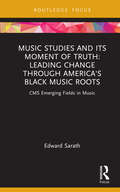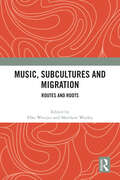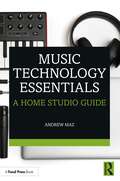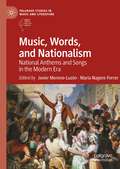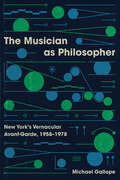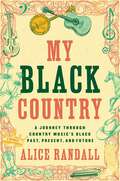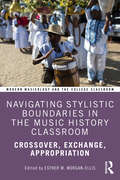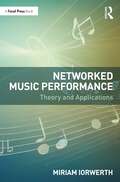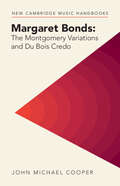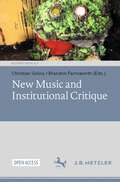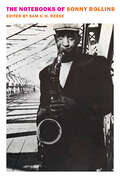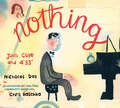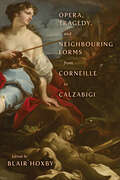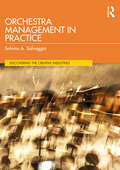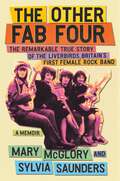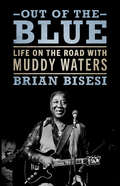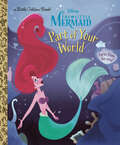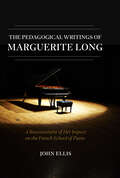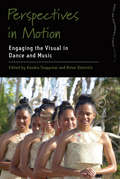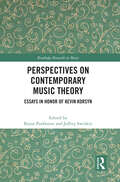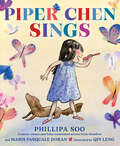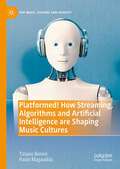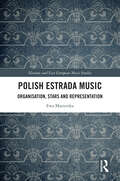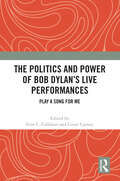- Table View
- List View
Music Studies and Its Moment of Truth: CMS Emerging Fields in Music (CMS Emerging Fields in Music)
by Edward SarathMusic Studies and Its Moment of Truth: Leading Change through America’s Black Music Roots presents a new framework for racial justice discourse in the context of music studies and education. Centering on Black American Music, the book issues challenges to both the conventional music studies paradigm and decades-old reform efforts. While Black American Music ranks high among America’s contributions to world culture, and offers musicians powerful tools for musical practice and understanding, this musical legacy remains remarkably marginalized even in activist conversations. The author argues that this reflects lingering and unexamined racist patterns that persist even among the most fervent voices for anti-racist interventions, and addresses the need for a higher-order activist framework within music studies. Delving further into the transformative changes needed to pursue racial justice, the short pieces collected in this book discuss topics including a shift from multicultural ideology to a transcultural model of musical pluralism, analysis of the multi-tiered nature of musical racism, the whitewashing of music studies activism, K-12 music teacher education as the locus for paradigmatic change and the potential for a transformed model of music studies to catalyze an overarching revolution in creativity and consciousness in both education and society at large. Critiquing the failures of progressive reform efforts and conventional reaction, this book argues that major changes are needed to the discourse on racism in music studies, and envisions new paradigms for the future.
Music Studies and Its Moment of Truth: CMS Emerging Fields in Music (CMS Emerging Fields in Music)
by Edward SarathMusic Studies and Its Moment of Truth: Leading Change through America’s Black Music Roots presents a new framework for racial justice discourse in the context of music studies and education. Centering on Black American Music, the book issues challenges to both the conventional music studies paradigm and decades-old reform efforts.While Black American Music ranks high among America’s contributions to world culture, and offers musicians powerful tools for musical practice and understanding, this musical legacy remains remarkably marginalized even in activist conversations. The author argues that this reflects lingering and unexamined racist patterns that persist even among the most fervent voices for anti-racist interventions, and addresses the need for a higher-order activist framework within music studies.Delving further into the transformative changes needed to pursue racial justice, the short pieces collected in this book discuss topics including a shift from multicultural ideology to a transcultural model of musical pluralism, analysis of the multi-tiered nature of musical racism, the whitewashing of music studies activism, K-12 music teacher education as the locus for paradigmatic change and the potential for a transformed model of music studies to catalyze an overarching revolution in creativity and consciousness in both education and society at large. Critiquing the failures of progressive reform efforts and conventional reaction, this book argues that major changes are needed to the discourse on racism in music studies, and envisions new paradigms for the future.
Music, Subcultures and Migration: Routes and Roots
by Elke Weesjes Matthew WorleyThis edited volume concentrates on the period from the 1940s to the present, exploring how popular music forms such as blues, disco, reggae, hip hop, grime, metal and punk evolved and transformed as they traversed time and space. Within this framework, the collection traces how music and subcultures travel through, to and from democracies, autocracies and anocracies.The chosen approach is multidisciplinary and deliberately diverse. Using both archival sources and oral testimony from a wide variety of musicians, promoters, critics and members of the audience, contributors from a range of academic disciplines explore music and subcultural forms in countries across Asia, Europe, Oceania, North America and Africa. They investigate how far the meaning of music and associated subcultures change as they move from one context to another and consider whether they transcend or blur parameters of class, race, gender and sexuality.
Music Technology Essentials: A Home Studio Guide
by Andrew MazMusic Technology Essentials provides an overview of the vocabulary, techniques, concepts, and devices used in contemporary music production and guides readers through the essential fundamentals of music technology so that they can create their own music productions at home. This highly accessible book covers sound fundamentals and theory, as well as practical topics like hardware, software, MIDI, digital audio, synthesis, computer notation, and audio-visual applications, to equip the reader with the principles they need to achieve professional-sounding results. Each chapter is accompanied by real-life examples and exercises that can be applied to any digital audio workstation software, to put the lessons into practice. This book will also help readers evaluate their requirements for home music production while working within a sensible budget. Music Technology Essentials is the ideal textbook for beginners inside and outside of the classroom, including those on music and music production courses, who wish to enter the world of music technology but are unsure where to start or what to purchase.
Music, Words, and Nationalism: National Anthems and Songs in the Modern Era (Palgrave Studies in Music and Literature)
by Javier Moreno-Luzón María Nagore-FerrerMusic, Words and Nationalism: National Anthems and Songs in the Modern Era considers the concept of nationalism from 1780 to 2020 through anthems and national songs as symbolic and representative elements of the national identity of individuals, peoples, or collectivities. The volume shows that both the words and music of these works reveal a great deal about the defining features of a nation, its political and cultural history, and its self-perception. The book takes an interdisciplinary approach that provides a better understanding of the role of national anthems and songs in the expression of national identities and nationalistic goals. From this perspective, the relationship between hymns and political contexts, their own symbolic content (both literary and musical) and the role of specific hymns in the construction of national sentiments are surveyed.
The Musician as Philosopher: New York’s Vernacular Avant-Garde, 1958–1978
by Michael GallopeAn insightful look at how avant-garde musicians of the postwar period in New York explored the philosophical dimensions of music’s ineffability. The Musician as Philosopher explores the philosophical thought of avant-garde musicians in postwar New York: David Tudor, Ornette Coleman, the Velvet Underground, Alice Coltrane, Patti Smith, and Richard Hell. It contends that these musicians—all of whom are understudied and none of whom are traditionally taken to be composers—not only challenged the rules by which music is written and practiced but also confounded and reconfigured gendered and racialized expectations for what critics took to be legitimate forms of musical sound. From a broad historical perspective, their arresting music electrified a widely recognized social tendency of the 1960s: a simultaneous affirmation and crisis of the modern self.
My Black Country: A Journey Through Country Music's Black Past, Present, and Future
by Alice RandallAlice Randall, award-winning professor, songwriter, and author with a &“lively, engaging, and often wise&” (The New York Times Book Review) voice, offers a lyrical, introspective, and unforgettable account of her past and her search for the first family of Black country music.Country music had brought Randall and her activist mother together and even gave Randall a singular distinction in American music history: she is the first Black woman to cowrite a number one country hit, Trisha Yearwood&’s &“XXX&’s and OOO&’s&”. Randall found inspiration and comfort in the sounds and history of the first family of Black country music: DeFord Bailey, Lil Hardin, Ray Charles, Charley Pride, and Herb Jeffries who, together, made up a community of Black Americans rising through hard times to create simple beauty, true joy, and sometimes profound eccentricity. What emerges in My Black Country is a celebration of the most American of music genres and the radical joy in realizing the power of Black influence on American culture. As country music goes through a fresh renaissance today, with a new wave of Black artists enjoying success, My Black Country is the perfect gift for longtime country fans and a vibrant introduction to a new generation of listeners who previously were not invited to give the genre a chance.
Navigating Stylistic Boundaries in the Music History Classroom: Crossover, Exchange, Appropriation (Modern Musicology and the College Classroom)
by Esther M. Morgan-EllisAt a time of transformation in the music history classroom and amid increasing calls to teach a global music history, Navigating Stylistic Boundaries in the Music History Classroom adds nuance to the teaching of varied musical traditions by examining the places where they intersect and the issues of musical exchange and appropriation that these intersections raise. Troubling traditional boundaries of genre and style, this collection of essays helps instructors to denaturalize the framework of Western art music and invite students to engage with other traditions—vernacular, popular, and non-Western—on their own terms.The book draws together contributions by a wide range of active scholars and educators to investigate the teaching of music history around cases of stylistic borders, exploring the places where different practices of music and values intersect. Each chapter in this collection considers a specific case in which an artist or community engages in what might be termed musical crossover, exchange, or appropriation and delves deeper into these concepts to explore questions of how musical meaning changes in moving across worlds of practice. Addressing works that are already widely taught but presenting new ways to understand and interpret them, this volume enables instructors to enrich the perspectives on music history that they present and to take on the challenge of teaching a more global music history without flattening the differences between traditions.
Networked Music Performance: Theory and Applications
by Miriam IorwerthNetworked Music Performance (NMP) is the essential guide to both playing music online and ensemble music through networks. Offering a range of case studies, from highly technical solutions to inclusive community projects, this book provides inspiration to musicians to try NMP whatever their level of technical expertise. Drawing upon recent research to examine the background and history of the practice as well as specific practical approaches, technical and musical considerations are included for readers, as are ideas around accessibility and creativity. Accessibility is considered in the context of the opportunities that NMP gives to musicians working remotely, as well as some of the barriers to participation in NMP and how these can be overcome. Synchronous and asynchronous approaches to NMP are explored in detail, examining the technical and musical affordances and challenges of working remotely for musicians. Networked Music Performance will appeal to music and music technology students as well as professional musicians and technicians who have started working online and wish to improve their practice. As NMP in the context of music education and community music are also explored, this book supplies educators and community leaders with knowledge and practical guidance on how to move their practice online.
New Cambridge Music Handbooks: The Montgomery Variations And Du Bois Credo (New Cambridge Music Handbooks Ser.)
by John Michael CooperNew Music and Institutional Critique (Ästhetiken X.0 – Zeitgenössische Konturen ästhetischen Denkens)
by Christian Grüny Brandon FarnsworthWhile institutional critique has long been an important part of artistic practice and theoretical debate in the visual arts, it has long escaped attention in the field of music. This open access volume assembles for the first time an array of theoretical approaches and practical examples dealing with New Music’s institutions, their critique, and their transformations. For scholars, leaders, and practitioners alike, it offers an important overview of current developments as well as theoretical reflections about New Music and its institutions today. In this way, it provides a major contribution to the debate about the present and future of contemporary music.
The Notebooks of Sonny Rollins
by Sonny RollinsAn illuminating selection of writings on a wide variety of topics—everything from technique, music theory, and daily routine to spirituality and systemic racism—from the personal journals of Sonny Rollins, master of the tenor saxophone and &“jazz&’s greatest living improviser&” (The New York Times).Sonny Rollins is one of the towering masters of American music, a virtuoso of the saxophone, and an unequaled improviser whose live performances are legendary and who has reshaped modern jazz time and time again over the course of a career lasting more than sixty years. A turning point in that legendary career came in 1959, when Rollins stepped back from performing and recording to begin a new regime of musical exploration, which saw him practicing for hours, sometimes all through the night, on the Williamsburg Bridge. This was also the moment when he started the notebook that would become a trusted companion in years to come—not a diary so much as a place to ponder art and life and his own search for meaning in words and in images.At once quotidian and aphoristic, the notebooks mingle lists of chores and rehearsal routines with ruminations on nightclub culture, racism, and the conundrums of the inner life. And always there is the music—questions of embouchure, fingering, and technique; of harmony and dissonance; of his own and others&’ art and the art of jazz. &“Any definition,&” Rollins insists, &“which seeks to separate Johann Sebastian Bach from Miles Davis is defeating its own purpose of clarification. . . .The Musings of Miles is then the Bouncing of Bach both played against each other.&” Edited and introduced by the critic and jazz scholar Sam V.H. Reese, The Notebooks of Sonny Rollins provides an unequaled glimpse into the mind and workshop of a musical titan, as well as a wealth of insight and inspiration to readers.
Nothing: John Cage and 4'33"
by Nicholas DayWhat does nothing sound like? An offbeat history of John Cage&’s 4&’33&”, a musical composition of blank bars, illustrated by Caldecott Medalist Chris Raschka.One night in 1952, master pianist David Tudor took the stage in a barnlike concert hall called the Maverick. A packed audience waited with bated breath for him to start playing. Little did they know that the performance had already begun. A rain patters.A tree rustles.An audience stirs. David was performing John Cage&’s 4&’33&”, whose purpose is to amplify the ambient sounds of whatever venue it inhabits. That shocking first performance earned 4&’33&” plenty of haters; and yet the piece endures, &“performed&” by the smallest garage bands and the grandest symphonies alike, year after year. Its fans hear what John Cage hoped we would hear: &“Nothing&” is never silent, and you don&’t need a creative genius, a concert hall, or even a piano to hear something worthwhile. All you have to do is stop and listen.Nicholas Day&’s text is reverent with a healthy drop of humor, warm and refined; two-time Caldecott Medalist Chris Raschka&’s childlike pencil-on-watercolor artwork is uninhibited and electrifying, with all the visionary spirit of the work it chronicles. Guaranteed to spark generative thought and lively debate among readers of all ages, Nothing is not to be missed.A Junior Library Guild Gold Standard Selection
Opera, Tragedy, and Neighbouring Forms from Corneille to Calzabigi
by Blair HoxbySince the nineteenth century, some of the most influential historians have portrayed opera and tragedy as wholly distinct cultural phenomena. These historians have denied a meaningful connection between the tragedy of the ancients and the efforts of early modern composers to arrive at styles that were intensely dramatic. Drawing on a series of case studies, Opera, Tragedy, and Neighbouring Forms from Corneille to Calzabigi traces the productive, if at times rivalrous, relationship between opera and tragedy from the institution of French regular tragedy under Richelieu in the 1630s to the reform of opera championed by Calzabigi and Gluck in the late eighteenth century. Blair Hoxby and his fellow contributors shed light on “neighbouring forms” of theatre, including pastoral drama, tragédie en machines, tragédie en musique, and Goldoni’s dramma giocoso. Their analysis includes famous masterpieces by Corneille, Voltaire, Metastasio, Goldoni, Calzabigi, Handel, and Gluck, as well as lesser-known artists such as Luisa Bergalli, the first female librettist to write for the public theatre in Italy. Opera, Tragedy, and Neighbouring Forms from Corneille to Calzabigi delves into a series of quarrels and debates in order to illuminate the history of seventeenth- and eighteenth-century theatre.
Orchestra Management in Practice (Discovering the Creative Industries)
by Salvino A. SalvaggioIntroducing the business models, organisational structures, and fundamentals of orchestras, this book takes readers on a journey through the evolution of orchestra management. The author explores the dynamics between artistic excellence and financial sustainability. Key aspects of orchestra management are examined in detail, including artistic programming, strategic planning, financial and compliance/legal matters, audience development, resilience and adaptability, governance and board relations, diversity and inclusion, partnerships, and the role of technology and innovation. With actionable resources, such as checklists, templates, and frameworks, for current and future orchestra leaders and managers, this comprehensive guide empowers readers in education and practice to navigate the complexities of orchestra management confidently and effectively.
The Other Fab Four: The Remarkable True Story of the Liverbirds, Britain's First Female Rock Band
by Mary McGlory Sylvia SaundersFor readers of Sheila Weller&’s Girls Like Us comes a fiercely feminist, heartwarming story of friendship and music about The Liverbirds, Britain&’s first all-female rock group. The idea for Britain&’s first female rock band, The Liverbirds, started one evening in 1962, when Mary McGlory, then age 16, saw The Beatles play live at The Cavern Club in Liverpool, the nightclub famously known as the &“cradle of British pop music.&” Then and there, she decided she was going to be just like them—and be the first girl to do it. Joining ranks in 1963 with three other working-class girls from Liverpool—drummer Sylvia Saunders and guitarists Valerie Gell and Pamela Birch, also self-taught musicians determined to &“break the male monopoly of the beat world&”—The Liverbirds went on to tour alongside the Rolling Stones, the Kinks, and Chuck Berry, and were on track to hit international stardom—until life intervened, and the group was forced to disband just five years after forming in 1968. Now, Mary and Sylvia, the band&’s two surviving members, are ready to tell their stories. From that fateful night in 1962, when Mary, who once aspired to become a nun, decided to provide for her family by becoming a rich-and-famous rocker, to the circumstances that led to the band splitting up—Sylvia&’s dangerously complicated pregnancy, and the tragic accident that paralyzed Valerie&’s beau—The Liverbirds tackles family, friendship, addiction, aging, and the forces—even destiny—that initially brought the four women together.
Out of the Blue: Life on the Road with Muddy Waters (American Made Music Series)
by Brian BisesiOut of the Blue: Life on the Road with Muddy Waters begins with a moment lifted from a young musician’s dreams. Brian Bisesi, a guitarist barely out of his teens, is invited on stage to fill in for a missing member of the band backing blues legend Muddy Waters. This life-changing quirk of fate opens the door into a world of challenges and opportunities that Bisesi, an Italian American reared in the comforts of a New York City suburb, can barely imagine. Despite their differences, Bisesi and Waters hit it off, and what might have been a one-night stand turns into a career. From 1978 to 1980, Bisesi works for Waters as his road manager, bean-counter, and at times his confidant, while often sitting in with the band. Bisesi’s years with the band take him to Europe, Japan, Canada, and across the United States as Waters tours—and parties—with rock gods like Eric Clapton, the Rolling Stones, a Beatle, and the gamut of musicians who came of age with Waters and introduced a younger generation to the blues. In Out of the Blue, Bisesi captures it all: from the pranks and tensions among bluesmen enduring a hard life on the road, to observations about Waters’s technique, his love of champagne and reefer, his eye for women, and his sometimes-acrid views of contemporary music. Bisesi has sharp insights into the ill-conceived management decisions that led to the dissolution of Waters’s longest-serving band in June of 1980. This book will rivet, amuse, and occasionally infuriate blues aficionados. It is a raucous and intimate portrait of the blues scene at a pivotal moment in time that fascinates music historians and blues fans alike.
Part of Your World (Little Golden Book)
by Howard Ashman Alan MenkenSing along to the iconic Disney song "Part of Your World" from The Little Mermaid with this beautifully illustrated Little Golden Book. Perfect for children ages 2 to 5!Dive under the sea and join Disney Princess Ariel as she dreams about what it would be like to join the human world! This beautiful Little Golden Book features the lyrics to the beloved song "Part of Your World" as well as illustrated scenes from the movie and is sure to be a treasure for children ages 2 to 5 as well as Little Golden Book collectors and Disney fans of all ages.Little Golden Books enjoy nearly 100% consumer recognition. They feature beloved classics, hot licenses, and new original stories. . . the classics of tomorrow.
The Pedagogical Writings of Marguerite Long: A Reassessment of Her Impact on the French School of Piano
by John EllisMarguerite Long, the most important French female pianist of the 20th century, left her stamp on a whole epoch of musical life in Paris. The Pedagogical Writings of Marguerite Long presents English translations of the two major contributions of Marguerite Long to the literature of piano pedagogy. These translations of her pedagogical works, Le Piano and La Petite Méthode de piano, provide a window to the old French school of pianism as modernized by Long. Le Piano is a remarkable text offering piano playing techniques and pragmatic and philosophical musings and observations about life, musicians, careers, and more. La Petite Méthode de piano is a personal manifesto about how to introduce children to music. Both works are treasures revealing Long's lifelong commitment to teaching and they are still stunningly relevant. In addition, John Ellis analyzes each work and puts it in historical context. He places special emphasis on Long's illustrious international career, her teaching, her rivalry with Alfred Cortot, and the impact of sexism on her life and work. Ellis addresses the eclipse of Long's reputation by that of Cortot and fills a gap in the knowledge of Long's place in the history of pedagogical heritage.
Perspectives in Motion: Engaging the Visual in Dance and Music (Dance and Performance Studies #15)
by Kendra Stepputat Brian DiettrichFocusing on visual approaches to performance in global cultural contexts, Perspectives in Motion explores the work of Adrienne L. Kaeppler, a pioneering researcher who has made a number of interdisciplinary contributions over five decades to dance and performance studies. Through a diverse range of case studies from Oceania, Asia, and Europe, and interdisciplinary approaches, this edited collection offers new critical and ethnographic frameworks for understanding and experiencing practices of music and dance across the globe.
Perspectives on Contemporary Music Theory: Essays in Honor of Kevin Korsyn (Routledge Research in Music)
by Bryan Parkhurst Jeffrey SwinkinKevin Korsyn is a renowned music theorist, musicologist, and pedagogue who has taught at the University of Michigan since 1992. He has published widely and influentially in areas as diverse as Beethoven and Brahms studies, chromatic tonality, disciplinarity and metatheory, history of theory, musical meaning and hermeneutics, poststructuralism (deconstruction, intertextuality, etc.), and Schenkerian theory and analysis. Because of the scope and caliber of his published work, and also his legacy as a pedagogue, Korsyn has had a profound impact on the field of music theory, along with the related fields of historical musicology and aesthetics. This book, a festschrift for Korsyn, comprises essays that constellate around his numerous scholarly foci. Represented in the volume are not only familiar music-theoretical topics such as chromaticism, form, Schenker, and text-music relations, but also various interdisciplinary topics such as deconstruction, disability studies, German Idealism, posthumanism, and psychoanalysis. The book thus reflects the increasingly multifaceted intellectual landscape of contemporary music theory.
Piper Chen Sings
by Phillipa Soo Maris Pasquale DoranAn empowering story about a girl who turns her performance jitters into confidence when faced with singing a solo at her school concert. Inspired by the childhood experience of award-winning actress Phillipa Soo who originated the role of Eliza in Hamilton. <p><p>Piper Chen loves nothing more than to sing. She sings to the sun, and she sings to the moon. She sings to her stuffed animals and with the birds outside her window. So, when her music teacher asks if Piper would like to sing a solo in her school’s Spring Sing, all she can say is “yes!” But as practice continues, doubt and worry creep in and Piper’s confidence wavers. She feels like butterflies are having a dance party in her belly. At home, Piper finds Nai Nai, her grandmother, at the piano. They’ve always shared a love of music, and Piper knows if anyone can help her through the unsettling feeling in her stomach and to shine her brightest at the Spring Concert, it’s Nai Nai. <p><p>First time picture book writers and sisters-in-law, Phillipa Soo and Maris Pasquale Doran along with acclaimed illustrator Qin Leng have created a cheerful intergenerational and stunning story that inspires confidence in the face of nervousness <p> <b>New York Times Bestseller</b>
Platformed! How Streaming, Algorithms and Artificial Intelligence are Shaping Music Cultures (Pop Music, Culture and Identity)
by Tiziano Bonini Paolo MagauddaGrounded in more than a decade of field research, this book uses empirical examples, quantitative data, and qualitative interviews with young music consumers as well as music industry professionals to understand how the platforms behind music production, distribution and listening work in our digital society. Bringing together the perspectives from science and technology studies, media studies, and the political economy of digital platforms, the book outlines the process of mutual construction between music digital platforms and the cultural value of music in today’s society, and also reflects on the complicated relationship between the power of platforms and the agency of listeners.
Polish Estrada Music: Organisation, Stars and Representation (Slavonic and East European Music Studies)
by Ewa MazierskaPolish estrada music dominated Polish popular music throughout the state socialist period but gained little attention from popular music scholars because it was regarded as being of low quality and politically conformist. Ewa Mazierska carefully examines these assumptions, considering those institutions which catered for the needs of estrada artists and their fans, the presence of estrada in different media and the careers and styles of the leading stars, such as Mieczysław Fogg, Irena Santor, Violetta Villas, Anna German, Jerzy Połomski, Maryla Rodowicz, Zdzisława Sośnicka, Zbigniew Wodecki and Krzysztof Krawczyk. Mazierska also discusses the memory and legacy of estrada music in the post-communist period. The book draws on Poland’s cultural and political history and the history of Polish popular music and media, including television and radio. Mazierska engages with concepts such as genre, stardom and authenticity in order to capture the essence of Polish estrada music and to provide a comparison with popular music produced in other countries.
The Politics and Power of Bob Dylan’s Live Performances: Play a Song for Me
by Erin C Callahan Court CarneyEphemeral by nature, the concert setlist is a rich, if underexplored, text for scholarly research. How an artist curates a show is a significant aspect of any concert’s appeal. Through the placement of songs, variations in order, or the omission of material, Bob Dylan’s setlists form a meta-narrative speaking to the power and significance of his music. These essays use the setlists from concerts throughout Dylan’s career to study his approach to his material from the 1960s to the 2020s. These chapters, from various disciplinary perspectives, illustrate how the concert setlist can be used as a source to explore many aspects of Dylan’s public life. Finally, this collection provides a new method to examine other musicians across genres with an interdisciplinary approach to setlists and the selectivity of performance. Unique in its approach and wide-ranging scholarly methodology, this book deepens our understanding of Bob Dylan, the performer.
